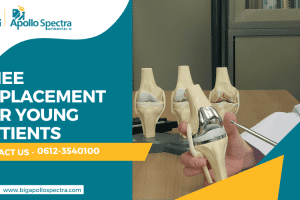Millions of people across the globe experience knee pain that varies from temporary discomfort to debilitating chronic conditions. However, proper treatment and management of knee pain is possible, but for that first you need to understand the difference between normal knee pain and arthritis knee pain.
Arthritis stands as a severe progressive disease which damages joint structure and function while temporary knee pain commonly arises from minor injuries and repetitive strain.
A common question among people is whether all knee pain is arthritis. The answer is no. Knee pain that is normal arises from physical activity or minor injuries, and you’ll notice it will resolve after rest and basic attention.
Arthritis knee pain originates from joint inflammation, cartilage damage, and structural changes that escalate, if not properly managed. Early recognition of these distinctions allows for prompt medical evaluation and suitable treatment approaches.
Following are the seven important distinctions that separate regular knee pain from arthritis-related knee pain.
Normal Knee Pain vs Arthritis Knee Pain: 7 Key Differences

Normal knee pain and arthritic pain are two distinct conditions that have some major difference in their pain pattern and recovery. We have listed down some main points to clarify what is the difference between normal knee pain and arthritis.
1. Pain Duration and Pattern
The onset of normal knee pain happens abruptly following particular activities, such as sports or minor injuries. Plus, rest and basic care usually resolve this kind of pain within a few days to weeks.
The discomfort also displays a consistent pattern where it intensifies during physical activity and diminishes during periods of rest.
Arthritis knee pain, in contrast, emerges slowly throughout months or years until it becomes a constant presence instead of an intermittent issue.
The pain continues to show intermittent changes but stays constant throughout. With arthritis knee pain, it’s common for individuals to experience morning stiffness that persists for over 30 minutes while pain also increases with weather fluctuations or after extended periods of inactivity.
PEOPLE ALSO READ: Arthritis Infection in Knee
2. Location and Radiation
Normal knee injuries typically produce pain that stays within the localized injured area. It can be front knee pain from falls or even side pain from twisting motions. The pain usually stays within its initial location and doesn’t extend to neighbouring joints or areas.
Arthritis pain, however, typically strikes the whole knee joint producing deep aching sensations which can even spread to the thigh or calf.
Arthritic pain stands apart because it spreads across multiple areas at once and can extend to other joints unlike typical knee pain which remains localized.
3. Stiffness Characteristics
Temporary stiffness in normal knee pain occurs after an injury, but you’ll get relief quickly when gentle movement and stretching are applied. The joint usually maintains its full range of motion and flexibility.
Arthritis produces persistent joint stiffness which majorly affects routine tasks.
Patients with early knee arthritis experience morning stiffness that lasts for extended periods while they can also encounter challenges bending or straightening their knees together with sensations that their joint gets “locked” or “frozen”. Some stiffness reduction occurs during movement, but it usually returns.
4. Swelling Patterns
A normal knee injury may lead to mild swelling which is a temporary situation. This swelling typically resolves within a few days when treated with ice application and elevation combined with rest.
On the other hand, arthritis initiates chronic inflammation which results in constant swelling. You may notice some slight changes, but this kind of swelling will never fully disappear.
Arthritic knee swelling often feels warm when touched and typically leads to visible enlargement of the joint. The best orthopedic doctor in Patna can help identify whether swelling is temporary or due to long-term inflammatory changes.
5. Activity Impact
Normal knee pain usually affects only those specific activities that are related to the injury or strain. For example, running may get uncomfortable following overuse yet walking and daily activities stay manageable.
Arthritis first affects high-impact exercises but continues to worsen until it restricts fundamental movements such as stair climbing and even the ability to walk short distances.
Functional capacity analysis reveals stark differences between normal vs arthritic knee pain since arthritic knees demonstrate a progressive decline in functionality as time passes.
6. Response to Rest
Rest combined with ice application and elevation leads to significant improvement in the case of normal knee pain.
Patients who maintain reduced activity levels for several days usually experience significant pain relief and restored normal function. But the pattern is quite different when it comes to arthritic pain.
Arthritis pain shows mixed responses to rest. Complete rest frequently leads to increased stiffness and discomfort while physical activity can cause temporary pain flare-ups.
As a result, active arthritis pain management requires the perfect balance of both activity and rest unlike normal knee pain which usually responds better to rest and protection.
7. Age and Gender Factors
Knee pain that occurs under normal conditions affects both men and women throughout all age ranges and usually results from physical activity or sports injuries.
In contrast, usually people over 50 experience arthritis pain more frequently than younger individuals, especially with osteoarthritis which is more common in women.
Knee pain in ladies typically occurs because of hormonal shifts during menopause, contributing to faster cartilage deterioration. Age-related changes make the structural and functional differences between normal knees and osteoarthritic knees increasingly noticeable.
Diagnostic Methods
A precise diagnosis starts with collecting a thorough medical history followed by conducting a physical examination. Healthcare professionals usually take the time to evaluate:
- joint mobility,
- pain patterns,
- swelling, and
- functional restrictions
These parameters help identify whether knee pain is originating from normal causes or arthritis.
Although other imaging techniques for arthritis diagnosis exist, X-rays serve as the main diagnostic tool for arthritis by displaying joint space narrowing along with bone spurs and cartilage damage.
MRI scans reveal soft tissue details which aid in detecting early knee arthritis symptoms before they become visible on X-rays.
Also, you may have to get a blood test done to confirm whether there’s presence of inflammatory arthritis such as rheumatoid arthritis. Complex cases necessitating detailed joint evaluations use advanced diagnostic methods such as ultrasound and CT scans.
Treatment Options
Most normal knee pain improvements come from basic treatments such as the RICE protocol along with pain relief medications and light stretching exercises. However, some persistent cases may require physical therapy as a treatment option.
A comprehensive arthritis treatment plan includes medication, physical therapy, lifestyle changes, and also surgical procedures (when necessary).
Most effective treatment for knee arthritis usually calls for a combination of anti-inflammatory medicines, joint injections, weight reduction efforts together with targeted exercise routines.
The early knee arthritis treatment aims at delaying disease advancement while supporting joint mobility.
In case you’re wondering about knee arthritis treatment without surgery, know that it usually combines physical therapy together with medications and injections and requires lifestyle adjustments to enhance your quality of life.
Patients can access solutions for arthritis symptom relief at a reputable bone hospital in Patna. We suggest you do not delay the required care and seek medical attention right away to better differentiate between normal knee pain and the pain due to arthritis.
Treat Pain: Timely Orthopedic Care Matters
Keeping informed enough to be able to tell normal knee pain apart from arthritis is an effective step in the right direction. However, self diagnosis is near to impossible in these painful conditions, and thus you require a doctor’s consultation to get proper medical attention and treatment.
Arthritis requires medical intervention to prevent progression and maintain joint function while basic self-care measures are usually sufficient to alleviate normal knee pain.
Timely identification combined with early treatment leads to better long-term results for patients with both conditions.
Persistent knee pain should not be dismissed or regarded as short-term discomfort. In fact, professional evaluation becomes vital when you suffer from continuous knee pain along with stiffness or functional limitations.
Big Apollo Spectra offers expert diagnosis and complete orthopedic care for knee conditions.
Big Apollo Spectra’s orthopedic specialists offer advanced diagnostic services together with personalized treatment plans for acute knee injuries as well as chronic arthritis conditions. We make it possible for you to get optimal care that’s most suited for your condition.





